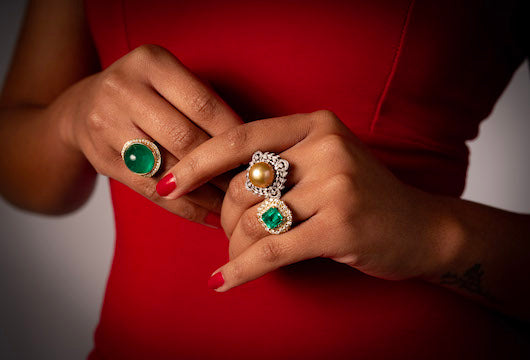Native American jewelry is one of the most highly collected styles of American-made jewelry. Rich, boldly colored gemstones set in intricately hand-worked silver are the hallmarks of Native American design. These pieces present a timeless aesthetic that appeals to collectors of all ages. While the seeds of the designs we see today emerged thousands of years ago, modern Native American jewelry as we know it only emerged as recently as the mid-19th century.
Deep Roots
Evidence of jewelry as a form of adornment in Native American societies dates back thousands of years in the archaeological record. The earliest known examples were used in religious ceremonies, trade, and as potent status symbols that helped delineate hierarchy in tribal society.
Tribes began to integrate silver and turquoise into their pieces in the 1850’s, when the arrival of Mexican silversmiths created a new interest in the use of these materials. Navajo (Diné) artists learned to work silver from these artists, and soon spread the skill to Zuni tribes with whom they traded. The Zuni in turn instructed the Hopi, and in a relatively short time a new and distinctive style of Native American jewelry had emerged. Initially, each tribe heavily borrowed stylistic elements from the other, but as the new artform progressed, stylistic features distinctive to each specific tribe began to emerge. Today, most pieces can be traced to one of three Native American Tribes: Navajo, Zuni, or Hopi.
Navajo
The Navajo were the first tribe to create turquoise and silver pieces that resembled the Native American jewelry so popular today. As they were honing the skills taught to them by Mexican silversmiths, copper mining in the Western United States was seeing a rapid increase. As more copper was excavated from the ground, turquoise was found in association with it in increasingly prolific deposits. Navajo artisans began to make use of this brightly colored, sky-blue stone by setting it into their silver work.
The earliest styles often featured beads and worked silver crafted from ingots. Because silver was still relatively difficult to acquire, The Navajo often used silver dollars or pesos that were melted and hand-hammered into stunning original designs. Soon, artisans began to request that any debts owed be paid in silver coinage to ensure an ample supply for their work.
One of the most characteristic forms of Navajo jewelry is the Squash Blossom necklace. The naja found at the center of squash blossom pieces was inspired by the Moorish-influenced crescent moon shapes that adorned the bridles of the horses of Spaniards that visited Navajo villages. Likewise, the “squash blossom” we refer to is a nod to the pomegranate blossoms so popular in Spanish art and imagery. Click here to read more about Navajo jewelry styles.
Zuni
Zuni artisans learned silversmithing techniques from the Navajo, trading livestock and other precious goods in exchange for tutelage in the new craft. While many of the earliest Zuni pieces are stylistically similar to Navajo works, imagery of nature and strong lapidary skills soon began to prevail in Zuni pieces. The Zuni are known for detailed cluster work, set with small red coral and turquoise pieces in petit point, needle point, and highly detailed inlay designs. To learn more about Zuni jewelry styles, click here.
Hopi
The Hopi began to manufacture silver jewelry later than the Zuni and Navajo, but soon established a unique composition style all their own. By the mid 1940’s, Hopi artisans were creating pieces representative of the Hopi style we are familiar with today.
The most widely recognized type of Hopi silverwork employs overlay by soldering together two sheets of silver, with designs inspired by traditional weaving and pottery cut into the top layer. The bottom layer is blackened and textured with chisels or stamping. This method allows the blackened, texturized underside to show through in sharp contrast with the silver cut-outs in the design. To learn more about Hopi jewelry styles click here.
Old Pawn Jewelry
Over time, the Navajo and other tribes began to use the beautiful pieces they created as a form of currency. Sterling necklaces, bracelets, rings, and concho belts could be “pawned” to traders and pawn shops for a specified period (usually 90 days to a year) and retrieved when financial burdens lessened. Tribal communities also used these transactions to safely store their pieces during the summer festival season, or at other periods when they spent much of their time traveling from place to place. Placing these pieces in pawn ensured their safekeeping until the owner had completed their journeys, much in the same way we use safety deposit boxes. Sometimes the original owner was unable to pay his debts, and the piece became the property of the pawn shop or trader in possession of the item.
Today, these pieces are referred to as “Old Pawn” jewelry and are some of the most highly coveted examples of Native American silver and lapidary work. Although the term is loosely used for silver pieces from the mid-19th to early 20th century with natural, unstabilized turquoise, coral, and other gems, it technically is only appropriately applied to Native American jewelry work with the pawn tags still attached to the item.
Counterfeits
Authentic, antique Navajo squash blossoms, Zuni petit point and inlay, and Hopi silverwork can easily reach prices in the tens of thousands of dollars on the jewelry market, with old pawn jewelry typically being the most expensive. Because many of these pieces were made using simple tools and designs, they are easily replicated by skilled hands.
There are a few key markers to look for when examining a piece of jewelry with unknown provenance. Most Native American jewelry is engraved with the artist’s name, nickname, or trademark. Signature styles and placement tend to be consistent for each artist. Take time to familiarize yourself with other pieces by the same designer to get a feel for their style and trademark.
A jeweler’s loupe can also be helpful in identifying wear patterns. Look for smoothness and reduced definition in the areas where a piece would most frequently be subjected to repeated friction, such as the ends and edges of bracelets and the end beads of necklaces.
Natural, unstabilized turquoise will rarely be a uniform clear blue color, instead typically exhibiting matrix lines and a greenish tinge because of interaction with the oils of the skin over the years. Generally speaking, if the condition of a piece looks too good to be true for its age, it probably is. Knowing the provenance of a piece and the reputation of the dealer selling the item are always an important component in assuring its authenticity when making significant purchases.


